2002 MERCEDES-BENZ S430 tire
[x] Cancel search: tirePage 284 of 430
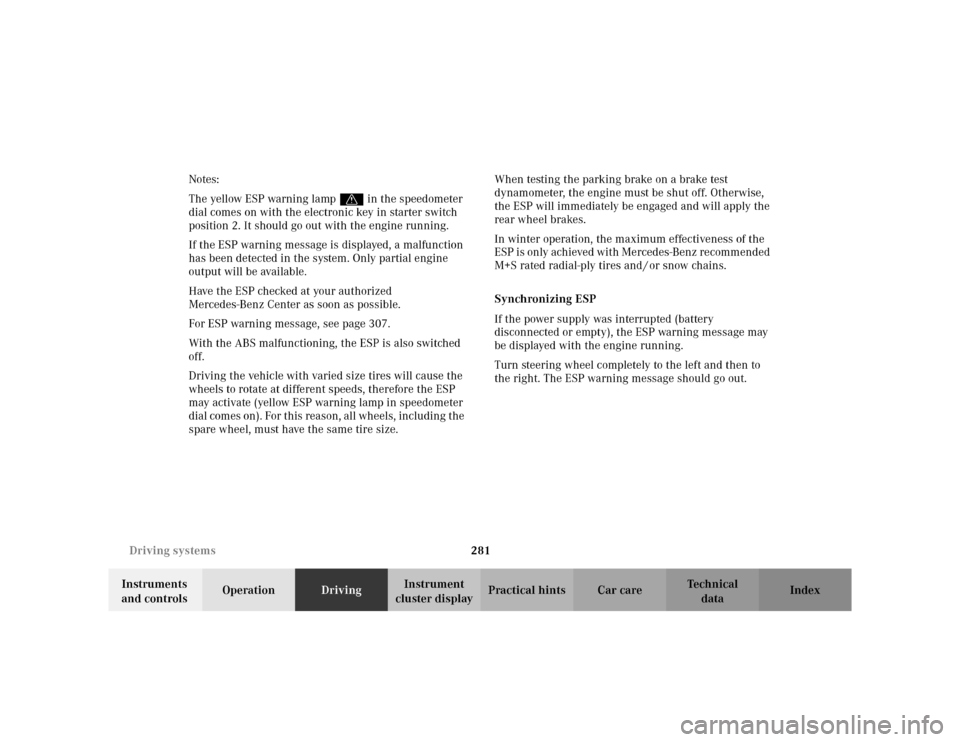
281 Driving systems
Te ch n i c a l
data Instruments
and controlsOperationDrivingInstrument
cluster displayPractical hints Car care Index Notes:
The yellow ESP warning lampv in the speedometer
dial comes on with the electronic key in starter switch
position 2. It should go out with the engine running.
If the ESP warning message is displayed, a malfunction
has been detected in the system. Only partial engine
output will be available.
Have the ESP checked at your authorized
Mercedes-Benz Center as soon as possible.
For ESP warning message, see page 307.
With the ABS malfunctioning, the ESP is also switched
off.
Driving the vehicle with varied size tires will cause the
wheels to rotate at different speeds, therefore the ESP
may activate (yellow ESP warning lamp in speedometer
dial comes on). For this reason, all wheels, including the
spare wheel, must have the same tire size. When testing the parking brake on a brake test
dynamometer, the engine must be shut off. Otherwise,
the ESP will immediately be engaged and will apply the
rear wheel brakes.
In winter operation, the maximum effectiveness of the
ESP is only achieved with Mercedes-Benz recommended
M+S rated radial-ply tires and / or snow chains.
Synchronizing ESP
If the power supply was interrupted (battery
disconnected or empty), the ESP warning message may
be displayed with the engine running.
Turn steering wheel completely to the left and then to
the right. The ESP warning message should go out.
Page 286 of 430
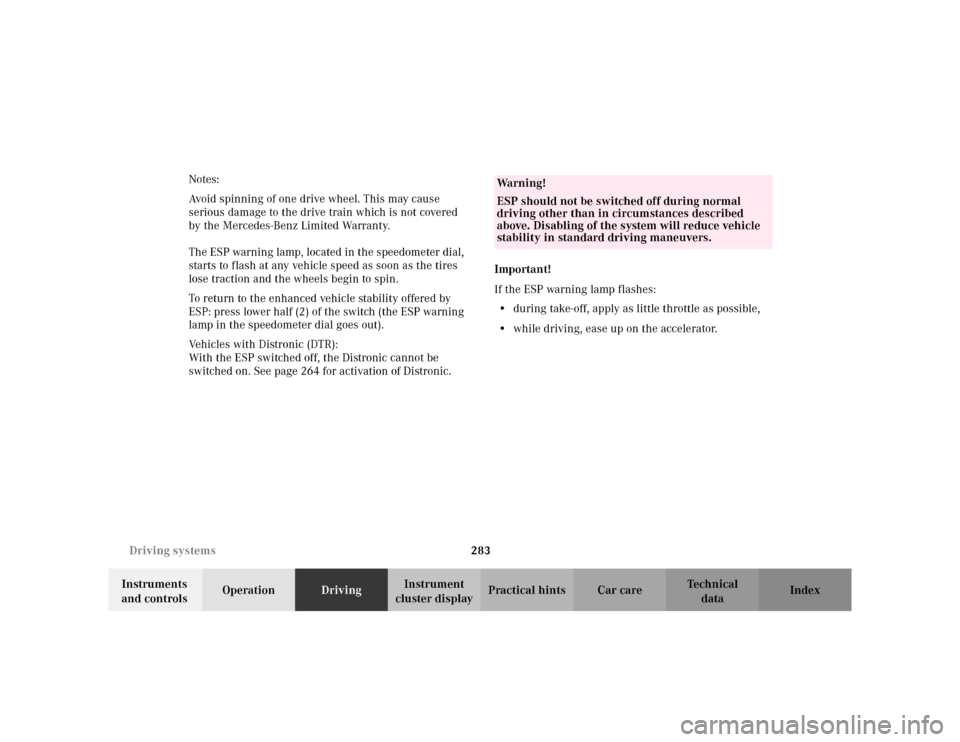
283 Driving systems
Te ch n i c a l
data Instruments
and controlsOperationDrivingInstrument
cluster displayPractical hints Car care Index Notes:
Avoid spinning of one drive wheel. This may cause
serious damage to the drive train which is not covered
by the Mercedes-Benz Limited Warranty.
The ESP warning lamp, located in the speedometer dial,
starts to flash at any vehicle speed as soon as the tires
lose traction and the wheels begin to spin.
To return to the enhanced vehicle stability offered by
ESP: press lower half (2) of the switch (the ESP warning
lamp in the speedometer dial goes out).
Vehicles with Distronic (DTR):
With the ESP switched off, the Distronic cannot be
switched on. See page 264 for activation of Distronic.Important!
If the ESP warning lamp flashes:
•during take-off, apply as little throttle as possible,
•while driving, ease up on the accelerator.
Wa r n i n g !
ESP should not be switched off during normal
driving other than in circumstances described
above. Disabling of the system will reduce vehicle
stability in standard driving maneuvers.
Page 291 of 430
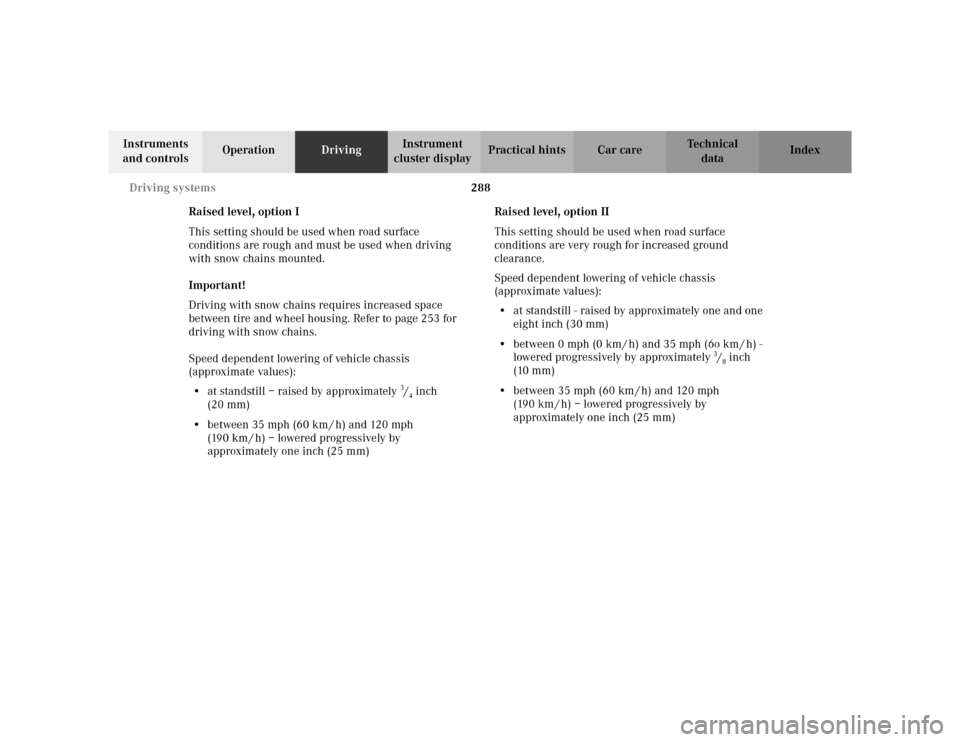
288 Driving systems
Te ch n i c a l
data Instruments
and controlsOperationDrivingInstrument
cluster displayPractical hints Car care Index
Raised level, option I
This setting should be used when road surface
conditions are rough and must be used when driving
with snow chains mounted.
Important!
Driving with snow chains requires increased space
between tire and wheel housing. Refer to page 253 for
driving with snow chains.
Speed dependent lowering of vehicle chassis
(approximate values):
•at standstill – raised by approximately
3/4 inch
(20 mm)
•between 35 mph (60 km / h) and 120 mph
(190 km / h) – lowered progressively by
approximately one inch (25 mm)Raised level, option II
This setting should be used when road surface
conditions are very rough for increased ground
clearance.
Speed dependent lowering of vehicle chassis
(approximate values):
•at standstill - raised by approximately one and one
eight inch (30 mm)
•between 0 mph (0 km / h) and 35 mph (6o km / h) -
lowered progressively by approximately
3/8 inch
(10 mm)
•between 35 mph (60 km / h) and 120 mph
(190 km / h) – lowered progressively by
approximately one inch (25 mm)
Page 301 of 430

298 What you should know at the gas station
Te ch n i c a l
data Instruments
and controlsOperationDrivingInstrument
cluster displayPractical hints Car care Index
Tire pressure
For tire pressure, refer to tire pressure label inside the
fuel filler flap. See page 356 for further details.
Air conditioner
R-134a refrigerant and special PAG lubricant, refer to
“Technical Data”.
Spark plugs
Approved spark plugs, refer to “Technical Data”.
Windshield cleaning
To prevent damage to the engine hood, the windshield
wipers must not be folded forward in parked position.
See page 388 for cleaning the windshield.Bulbs
High and low beams: H7 (55 W),
low beam: Xenon (optional)
fog lamps: H1 (55 W),
turn signal lamps,
front 2357 NA (28.5 / 8.3 W [Yellow]),
parking and standing lamps, front: W 5W (5 W)
side marker lamps, front: 5 W / 4 cp,
turn signal lamps, rear: 1156 NA bulb,
tail and parking lamp: P 21 / 4 W,
tail, parking and rear fog lamp, driver’s side: P 21 / 4 W,
tail, parking, standing and
side marker lamp: R 5 W / 4 cp,
backup lamps: 21 W / 32 cp,
license plate lamps: 5 W / 4 cp
Page 304 of 430

301 Contents – Instrument cluster display
Te ch n i c a l
data Instruments
and controlsOperation DrivingInstrument
cluster displayPractical hints Car care Index
Instrument cluster displayMalfunction and indicator
lamps in the
instrument cluster ....................302
On-board diagnostic
system ..........................................302
Check engine malfunction
indicator lamp .............................302
Brake warning lamp ..................304
Supplemental restraint system
(SRS) indicator lamp ..................305
Fuel reserve warning .................305
ABS malfunction
indicator lamp .............................306
Electronic stability program
(ESP) — warning lamp ...............307
Distronic (DTR) –
warning lamp ..............................307
Seat belt nonusage
warning lamp ..............................308Malfunction and indicator
lamp in the
center console ........................... 308
AIRBAG OFF indicator lamp .... 308
Malfunction and warning
messages in the
multifunction display .............. 309
DISPLAY DEFECTIVE ................. 310
BATTERY/ALTERNATOR ........... 311
ENTRANCE POSITION ...............312
BRAKE ASSIST ............................312
BRAKE LINING WEAR ............... 313
BRAKE FLUID ............................. 313
PARKING BRAKE ........................ 314
TRUNK OPEN .............................. 314
ELEC. STABIL. PROG.
(Electronic stability
program) ...................................... 315
COOLANT
(coolant level) .............................. 316
COOLANT
(coolant temperature) ................ 317LIGHTING SYSTEM .................... 318
LIGHT SENSOR ...........................320
ACTIVE BODY CONTROL
(ABC) ............................................320
TIRE PRESSURE .........................322
ENGINE OIL LEVEL ...................324
CRUISE CONTROL .....................325
KEY ...............................................325
DOOR ...........................................326
HOOD ...........................................326
TELE AID .....................................327
CHIP-CARD
(KEYLESS-GO) ............................328
SELECTOR LEVER ......................329
TELEPHONE – FUNCTION .......329
WASHER FLUID .........................330
AIR SPRING (AirMatic) ............. 331
DISTRONIC (DTR) ......................332
AIR CLEANER .............................333
Page 325 of 430
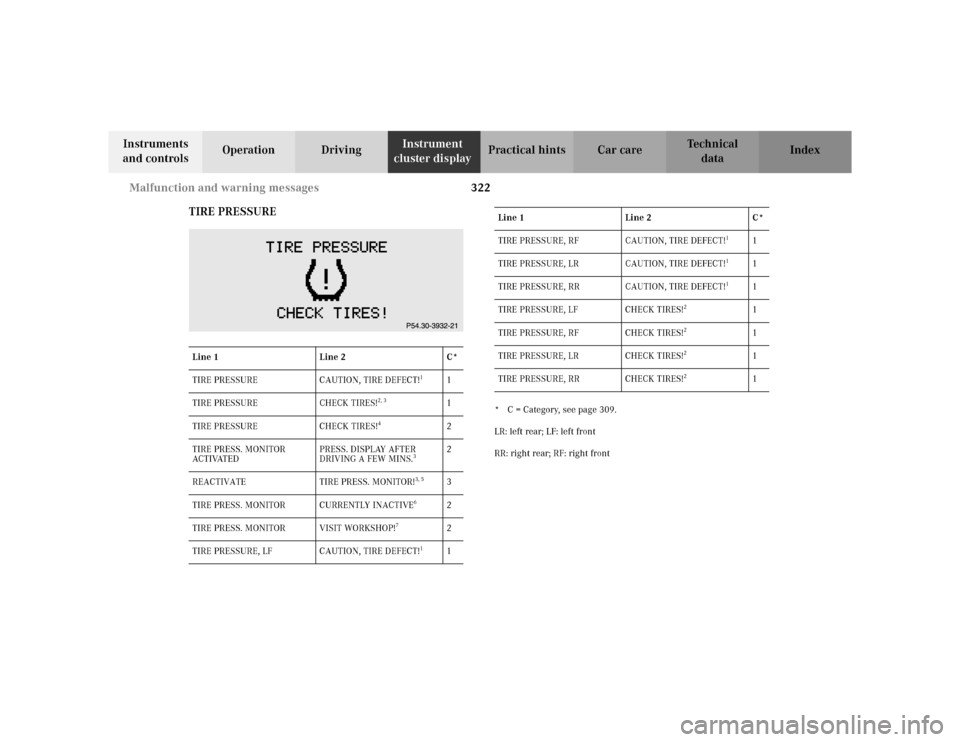
322 Malfunction and warning messages
Te ch n i c a l
data Instruments
and controlsOperation DrivingInstrument
cluster displayPractical hints Car care Index
TIRE PRESSURE
* C = Category, see page 309.
LR: left rear; LF: left front
RR: right rear; RF: right front Line 1 Line 2 C*
TIRE PRESSURE CAUTION, TIRE DEFECT!
1
1
TIRE PRESSURE CHECK TIRES!
2, 3
1
TIRE PRESSURE CHECK TIRES!
4
2
TIRE PRESS. MONITOR
ACTIVATEDPRESS. DISPLAY AFTER
DRIVING A FEW MINS.
3
2
REACTIVATE TIRE PRESS. MONITOR!
3, 5
3
TIRE PRESS. MONITOR CURRENTLY INACTIVE
6
2
TIRE PRESS. MONITOR VISIT WORKSHOP!
7
2
TIRE PRESSURE, LF CAUTION, TIRE DEFECT!
1
1
TIRE PRESSURE, RF CAUTION, TIRE DEFECT!
1
1
TIRE PRESSURE, LR CAUTION, TIRE DEFECT!
1
1
TIRE PRESSURE, RR CAUTION, TIRE DEFECT!
1
1
TIRE PRESSURE, LF CHECK TIRES!
2
1
TIRE PRESSURE, RF CHECK TIRES!
2
1
TIRE PRESSURE, LR CHECK TIRES!
2
1
TIRE PRESSURE, RR CHECK TIRES!
2
1 Line 1 Line 2 C*
Page 326 of 430
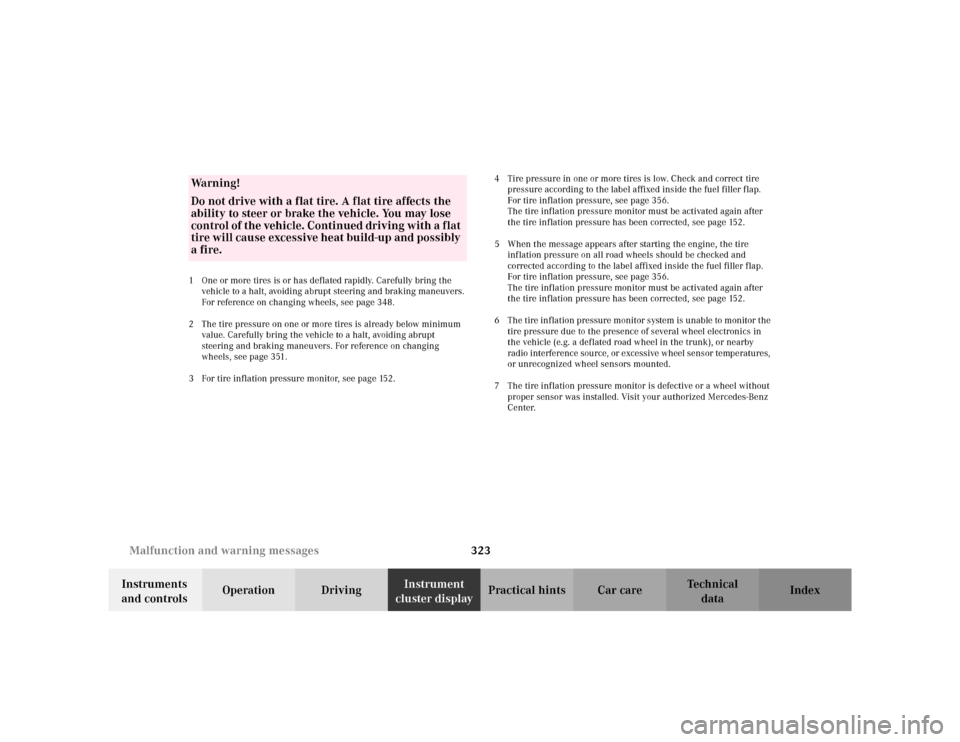
323 Malfunction and warning messages
Te ch n i c a l
data Instruments
and controlsOperation DrivingInstrument
cluster displayPractical hints Car care Index
1 One or more tires is or has deflated rapidly. Carefully bring the
vehicle to a halt, avoiding abrupt steering and braking maneuvers.
For reference on changing wheels, see page 348.
2 The tire pressure on one or more tires is already below minimum
value. Carefully bring the vehicle to a halt, avoiding abrupt
steering and braking maneuvers. For reference on changing
wheels, see page 351.
3 For tire inflation pressure monitor, see page 152.4 Tire pressure in one or more tires is low. Check and correct tire
pressure according to the label affixed inside the fuel filler flap.
For tire inflation pressure, see page 356.
The tire inf lation pressure monitor must be activated again after
the tire inflation pressure has been corrected, see page 152.
5 When the message appears after starting the engine, the tire
inflation pressure on all road wheels should be checked and
corrected according to the label affixed inside the fuel filler flap.
For tire inflation pressure, see page 356.
The tire inf lation pressure monitor must be activated again after
the tire inflation pressure has been corrected, see page 152.
6 The tire inflation pressure monitor system is unable to monitor the
tire pressure due to the presence of several wheel electronics in
the vehicle (e.g. a deflated road wheel in the trunk), or nearby
radio interference source, or excessive wheel sensor temperatures,
or unrecognized wheel sensors mounted.
7 The tire inflation pressure monitor is defective or a wheel without
proper sensor was installed. Visit your authorized Mercedes-Benz
Center.Wa r n i n g !
Do not drive with a flat tire. A flat tire affects the
ability to steer or brake the vehicle. You may lose
control of the vehicle. Continued driving with a flat
tire will cause excessive heat build-up and possibly
a fire.
Page 338 of 430
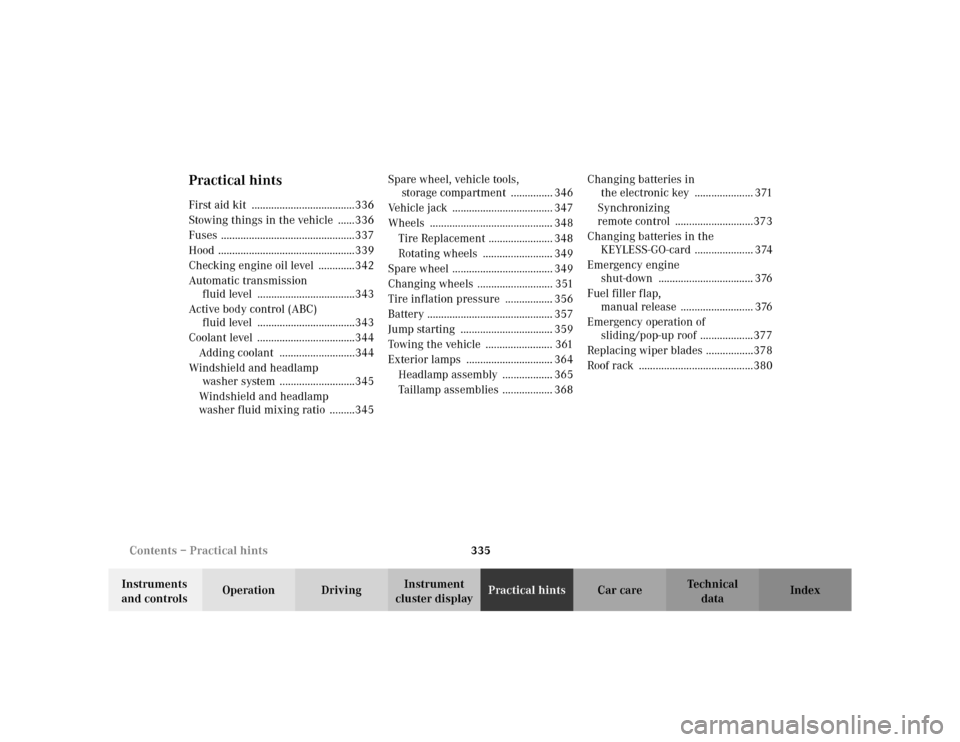
335 Contents – Practical hints
Te ch n i c a l
data Instruments
and controlsOperation DrivingInstrument
cluster displayPractical hintsCar care Index
Practical hintsFirst aid kit .....................................336
Stowing things in the vehicle ......336
Fuses ................................................337
Hood .................................................339
Checking engine oil level .............342
Automatic transmission
fluid level ...................................343
Active body control (ABC)
fluid level ...................................343
Coolant level ...................................344
Adding coolant ...........................344
Windshield and headlamp
washer system ...........................345
Windshield and headlamp
washer fluid mixing ratio .........345Spare wheel, vehicle tools,
storage compartment ............... 346
Vehicle jack .................................... 347
Wheels ............................................ 348
Tire Replacement ....................... 348
Rotating wheels ......................... 349
Spare wheel .................................... 349
Changing wheels ........................... 351
Tire inflation pressure ................. 356
Battery ............................................. 357
Jump starting ................................. 359
Towing the vehicle ........................ 361
Exterior lamps ............................... 364
Headlamp assembly .................. 365
Taillamp assemblies .................. 368Changing batteries in
the electronic key ..................... 371
Synchronizing
remote control ............................373
Changing batteries in the
KEYLESS-GO-card ..................... 374
Emergency engine
shut-down .................................. 376
Fuel filler flap,
manual release .......................... 376
Emergency operation of
sliding/pop-up roof ...................377
Replacing wiper blades .................378
Roof rack .........................................380